COMMERCIAL DIVER
HAND CRUSHED ON DIVE TO POSITION SEAMAR MATS
Root Causes of Incident
- Poor Pre-dive planning
- No formal JSA
- Poor communications between Dive Supervisor and Crane Operator
Bobby Delise and Alton Hall of Delise and Hall served as attorneys for “MD” a 39 year old commercial diver who sustained a severe crush injury to his arm when a nylon rigging strap broke underwater during dive off the coast Angola, Africa as he was attempting to reposition subsea mats.
Facts
This project involved a U.S. diving contractor providing services to a U.S. oil company off the coast of Angola. During the time of the incident the phase of the project involved the U.S. diving contractor’s process of certifying that the U.S. oil company’s pipeline was protected at areas where the pipeline crossed another pipeline.
The protection for the pipelines was afforded by subsea mats that acted as a cushions or buffers between the pipes. Earlier in the project the diving contractor discovered that one of the mats at a particular crossing was out of position. The crossover lay at depth of approximately 45 feet of water.
The goal of dive in incident was for “MD”, the diver, to help reposition the subsea mat to its proper location. In order to move the mat the diver’s supervisor designed a process to pull the mat employing the vessel’s crane with diver positioned at the crossover. The diver suggested using wire rope sling rigging instead of the nylon strap but was the suggestions vetoed by his supervisor who demanded nylon rigging. The diver accepted his supervisor’s directive and brought the nylon rigging to the crossover.
It was the plan to pull the mat into position by directing the vessel’s crane via the diver’s communications to the diving contractor’s supervisor on the vessel. At the depth of 45 feet the diver was working in zero visibility conditions.
On location the diver concluded that the mat was only feet from where it needed to be. He determined that he first had to jet out an area so that the mat could be pulled to its final position. Because the mats were tied together side-by-side with “zip-ties” it was necessary for the diver to disconnect one of the mats because it was impossible to pull the series of mats as each weighed between 2000-4000 pounds. He proceeded to cut the zip-ties. Once completing that task he rigged the nylon rigging to the mats and directed the supervisor to “come up” on the crane advising to hold off on the lift until he was in the “safe zone” and away from the “pull zone”.
On the first attempt the mat didn’t move in the direction planned; it was getting stuck or wedged in the mud. The diver concluded that the best way to remedy the problem was to jet out an area adjacent to the mat. After completing the jetting process the diver positioned himself with one foot on the mat (in order to gauge the mat’s movement) and lay prone adjacent to the mat. Once again, he assured himself that he was in a “safe zone”, away from the “pull zone”. He again directed the supervisor that he was positioned as planned and asked topside to commence the pull.
Prior to the second pull there were discussions between the diver and his supervisor with reference to the boom of the crane and the difficulty trying to pull the mat horizontally over a concrete covered pipe. The diver suggested that the boom be repositioned to make an even pull rather than placing strain on the bridle in uneven manner. It is unknown whether the supervisor correctly followed the diver’s observation though the results indicated that either he failed to do so or the crane operator didn’t follow his direction. Later investigation revealed poor communications between the supervisor and crane operator.
As the crane began the pull, the mat started to move in the correct direction. The facts discovered in litigation concluded that shortly after the commencement of the pull that the “crane jerked”. On bottom the diver immediately felt something strike his right arm, followed by intense pain. He aborted the dive, and fighting shock grabbed what was left of his right hand and struggled to the surface. Upon reaching the deck of the vessel he went into shock from the pain and after realizing that half of his right hand was missing.
Later investigation revealed that the nylon strap rigging failed and that most likely that the recoil of the rigging struck the diver’s right arm.
DELISE AND HALL’S REPRESENTATION OF THE DIVER AND SUBMISSIONS OF FAULT
Delise and Hall submitted that the lack of pre-dive planning, the supervision of the dive, poor choice of equipment and poor communications were the root causes of the incident.
The supervisor directed the dive and the diver at the worksite. The diver was working in zero visibility conditions completely at the direction of the supervisor on surface. It was the supervisor’s decision with respect to how the mat was moved and the rigging used on site. The supervisor was also responsible for the operations of the crane and the position of the boom before and during the pull. This incident occurred because the planning of the pull was done without regard to the possible consequences to the diver in the water.
The poor JSA showed the lack of pre-dive planning necessary for such a risky undertaking. While diving contractor’s manual requires a drafting of the JSA, and review of same, by the dive team prior to the commencement of the planned dive, such did not take place prior to the incident. None of the prerequisites afforded and mandated by proper use of JSA were followed.
Lastly, the operations of the crane operators and the poor communications between the diver support crew and crane operator were discovered. The evidence discovered in litigation was that time and time again the crane operators – all local Angolans – were barely able to understand English and were ignorant of the accepted hand signals for crane operations. The note that “the crane jerked” may be read as the cause and not the effect of the rigging failure. What is clear is that the diving contractor topside supervisor was responsible for how this pull was planned and undertaken.
Resolution
Delise and Hall’s efforts resulted in a settlement for the diver weeks before trial for $2.6 million. The diver sustained significant damage to his hand and was permanently disqualified from diving.


